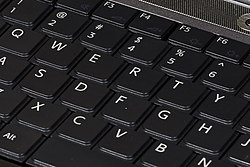Laptop keyboard repair is one of the more common jobs performed on laptops, it’s also one of the easier repairs to carry out providing the following hasn’t happened.
A spill of anything but water on a keyboard will 9 times out of 10 leave you in a situation that involves replacing the keyboard all together.
Keyboards are manufactured in such a way that leaves little to no room to clean out messy spills.
Basically any liquid containing sugar (soft drinks, beer, wine, coffee or tea) are bad news…
A couple of laptop keyboard repair do’s and don’ts in the event of a spill..
DON’T panic. Panic makes us do stupid things, think before you react.
DON’T use a hairdryer to dry out a spill…melted keys are hard to type with.
DON’T tilt the machine upside down or on its side (if you do feel the need it’s better to tilt it to the side that houses the CDROM as the CDROM area inside the machine has less components on it than the mainboard).
DO switch the machine off immediately and resist switching it back on until you’re certain the spill has dried. Survey the damage after you’ve dried it out. At this point you could remove the keyboard and try the machine using an external keyboard to see if anything else has been affected.
This diagram shows what a basic keyboard looks like, the ribbon cable which connects the keyboard to the motherboard is indicated by the red arrow.
The ribbon cable can also be located on the front edge of the keyboard depending on the age and model of the laptop you have.
Note the keyboard holder (thin strip of plastic) that sits on the top edge of the laptop keyboard needs to be removed to get access to the screws holding the keyboard down.
Most of the current laptop keyboards are like the diagram below.
Traditionally a spill will kill a keyboard or at best at least some function will be lost. I have only ever been successful with a laptop keyboard repair that involved a water spill, anything else normally results in a tragic loss and putting your old faithful keyboard to rest.. RIP.
How to replace a laptop keyboard
Keyboard removal is relatively simple, most keyboards are held in place with a couple of screws, and in some models, also a couple of screws that may need to be removed from the base of the unit. A quick call to your local authorized laptop computer repairer should help to determine what screws need to be removed (if they know their stuff).
The keyboard connector is something that needs a little care when unplugging, if you are too heavy handed and damage the connector in any way you may even damage the mainboard also which can cause a world of pain.. be careful.
See below for the most commonly used connector.
In order to release the keyboard ribbon cable ease the connector edge upwards only about 2 or 3 millimetres, the ribbon should now slip out with ease. The refitting of the keyboard once cleaned or replaced is just done in reverse.
Broken off some keys??
Whoops, these are a difficult one to fix and once again often end in having to replace the keyboard entirely. Some very small plastic mounting arms hold the keys in place and are often broken, either that or the little clips that the mounting arms click into break. It’s handy to have or get a hold of an old keyboard of the same type in order to poach the parts you need.
You may need some tweezers and a steady hand to fix these. The best thing I can suggest is to gently remove one of the other keys to see exactly how the mounting arms sit, once you have an idea of how it should look grab those tweezers and be patient, it may take some time.
We will soon have some detailed photos showing how these are assembled, until then remember to be patient and gentle.
If you seek professional advice regarding your laptop keyboard repair, the repairer will probably try to sell you a new keyboard complete with hefty labour charge to fix this for you. With the tips we have given you here, you can do your own laptop keyboard repair, fit it yourself and pocket the savings.

















